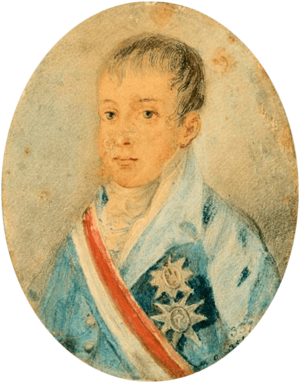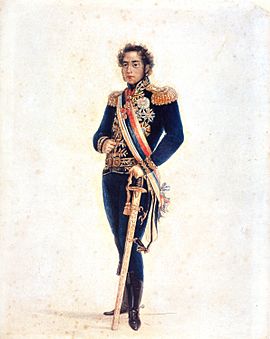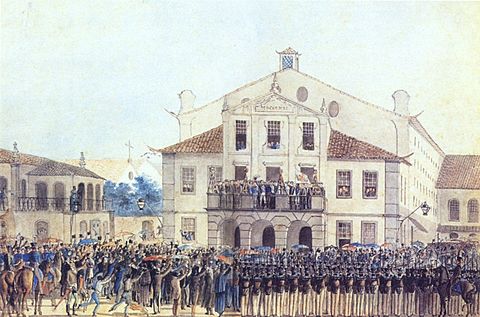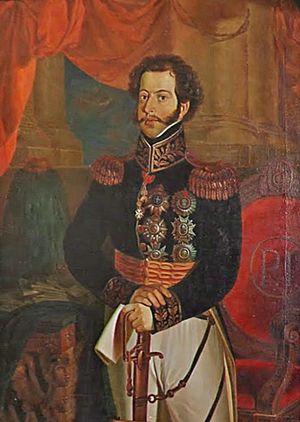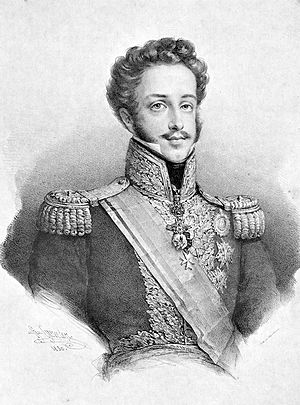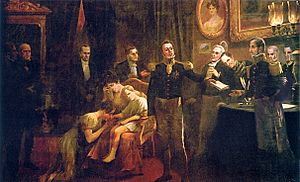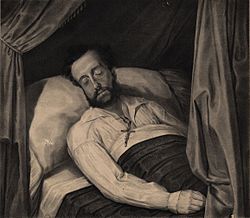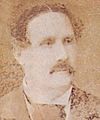Pedro I of Brazil facts for kids
Quick facts for kids
|
|||||
|---|---|---|---|---|---|
| Duke of Braganza | |||||
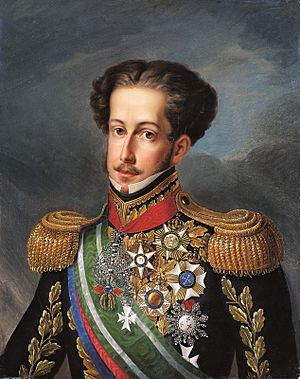
Portrait attributed to Simplício Rodrigues de Sá
|
|||||
| Emperor of Brazil | |||||
| Reign | 12 October 1822 – 7 April 1831 | ||||
| Coronation | 1 December 1822 Imperial Chapel |
||||
| Predecessor | John VI (as King of Brazil) | ||||
| Successor | Pedro II | ||||
| King of Portugal | |||||
| Reign | 10 March 1826 – 2 May 1826 | ||||
| Predecessor | John VI | ||||
| Successor | Maria II | ||||
| Born | 12 October 1798 Queluz Palace, Queluz, Portugal |
||||
| Died | 24 September 1834 (aged 35) Queluz Palace, Queluz, Portugal |
||||
| Burial | Monument to the Independence of Brazil | ||||
| Spouse | |||||
| Issue among others... |
|
||||
|
|||||
| House | Braganza | ||||
| Father | John VI of Portugal | ||||
| Mother | Carlota Joaquina of Spain | ||||
| Religion | Roman Catholicism | ||||
| Signature |  |
||||
Dom Pedro I (born 12 October 1798 – died 24 September 1834) was a very important leader. He was the founder and first ruler of the Empire of Brazil. People called him "the Liberator" because of his role in Brazil's independence. He was also King Dom Pedro IV of Portugal for a short time. In Portugal, he was known as "the Liberator" and "the Soldier King."
Pedro was born in Lisbon, Portugal. He was the fourth child of King John VI of Portugal and Queen Carlota Joaquina of Spain. In 1807, when French troops invaded Portugal, Pedro and his family had to flee. They sailed to Brazil, which was then Portugal's biggest colony.
In 1821, Pedro's father returned to Portugal. Pedro stayed in Brazil as the regent, meaning he ruled in his father's place. He faced many challenges from people who wanted changes. On 7 September 1822, Pedro chose to support Brazil. He declared Brazil's independence from Portugal. He became the Emperor of Brazil on 12 October 1822. By 1824, he had defeated all armies loyal to Portugal.
Later, a part of southern Brazil called Cisplatina tried to break away. This led to a war. In 1826, Pedro briefly became King of Portugal. But he soon gave up that crown to his eldest daughter, Maria II of Portugal. The war in Brazil ended with Cisplatina becoming the independent country of Uruguay. In Portugal, Pedro's younger brother, Miguel I of Portugal, took Maria II's throne.
Pedro faced problems in Brazil's parliament. It was hard for him to manage issues in both Brazil and Portugal at the same time. On 7 April 1831, he decided to give up his throne in Brazil. His young son, Pedro II of Brazil, became the new emperor. Pedro I then sailed back to Europe.
In July 1832, Pedro I led an army to Portugal. He fought against his brother Miguel to restore his daughter Maria II to the throne. This conflict was part of a bigger struggle across the Iberian Peninsula (Spain and Portugal). It was a fight between those who wanted more freedom and those who wanted kings to have absolute power. Pedro I and his supporters won. He died of tuberculosis on 24 September 1834. People remember him as a key figure who helped bring more modern, representative governments to both Brazil and Portugal.
Contents
Early Life
Birth and Family
Pedro was born on 12 October 1798, at the Palace of Queluz near Lisbon, Portugal. His full name was very long! From birth, he was called "Dom," which means "Lord."
His father was Prince Dom John (who later became King John VI of Portugal). His mother was Dona Carlota Joaquina of Spain. Pedro's parents did not have a happy marriage. His mother was very ambitious and often put Spain's interests first.
Pedro became his father's heir in 1801, after his older brother, Francisco António, passed away. His grandmother, Queen Maria I, was unwell, so his father was already ruling Portugal. Pedro and his siblings lived mostly with their grandmother, away from their parents.
Moving to Brazil and Education
In November 1807, when Pedro was nine, the French army led by Napoleon invaded Lisbon. The royal family had to escape quickly. They sailed to Rio de Janeiro, which was the capital of Brazil at the time. They arrived in March 1808.
Pedro loved to read and learn about navigation during the voyage. In Brazil, he lived with his younger brother Miguel and their father in the Paço de São Cristóvão palace. Pedro was not very close to his father, but he loved him.
Pedro had a governess, Maria Genoveva, whom he loved like a mother. He also had a mentor, Friar António de Arrábida, who taught him many subjects. These included math, history, and geography. He learned to speak and write Portuguese, Latin, and French. He could also understand English and German. Even as an emperor, he spent at least two hours a day studying.
Despite his studies, Pedro was very energetic and sometimes impulsive. He found it hard to control himself. His father never really disciplined him. Pedro often preferred physical activities over classroom lessons.
Hobbies and First Marriage
Pedro loved activities that used his physical skills. He was an excellent horseman and good at training horses. He also enjoyed drawing and making things with wood. He had a great love for music. He became a good composer and could play several instruments like the piano, flute, and guitar. He even composed Brazil's Independence Anthem.
Pedro was a simple person. He often wore comfortable clothes and liked to talk to people on the street. He was very energetic and sometimes short-tempered.
On 13 May 1817, Pedro married Maria Leopoldina of Austria by proxy. This means someone stood in for him during the ceremony. When she arrived in Rio de Janeiro on 5 November, she was surprised by how charming Pedro was. He was 19, handsome, and always neat and clean. Their wedding ceremony happened the next day. They had seven children together, including Maria II of Portugal and Pedro II of Brazil.
Brazil's Independence
The Liberal Revolution
In October 1820, news arrived that there was a revolution in Portugal. The military took over the government and wanted a new Constitution. Pedro's father, King John VI, asked Pedro for advice. He decided to send Pedro to Portugal to rule as regent. This was surprising because Pedro had never been involved in state affairs before.
Pedro was known for supporting liberalism, which meant he believed in a government with a constitution and elected representatives. His father and his advisors preferred absolute monarchy, where the king had all the power.
On 26 February 1821, Portuguese troops in Rio de Janeiro rebelled. Pedro decided to act. He met with the rebels and convinced his father to agree to their demands. On 21 April, a group of people tried to form a revolutionary government. Pedro sent army troops to restore order.
King John VI and his family left for Portugal on 26 April, leaving Pedro and Maria Leopoldina in Brazil. Before leaving, the King told his son: "Pedro, if Brazil breaks away, let it rather do so for you, who will respect me, than for one of those adventurers."
"Independence or Death!"
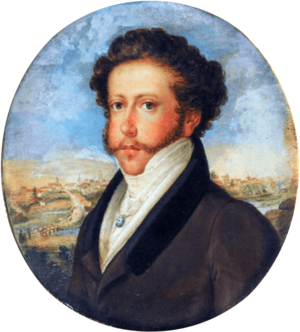
As regent, Pedro made new laws that protected people's rights and property. He also lowered government spending and taxes.
The situation became very tense when the Portuguese government ordered Pedro to return to Portugal. Brazilians saw this as an attempt to make Brazil a colony again. Brazil had been a kingdom since 1815, not just a colony. On 9 January 1822, Pedro received a petition with 8,000 signatures asking him to stay. He replied, "Since it is for the good of all and the general happiness of the Nation, I am willing. Tell the people that I am staying."
Portuguese troops rebelled again, trying to force Pedro to leave. This time, Pedro fought back. He gathered Brazilian troops and armed citizens. The Portuguese troops surrendered and were sent out of Brazil.
Pedro tried to keep some connection with Portugal, but a complete break was coming. He traveled to different parts of Brazil to gain support. On 7 September 1822, while returning from São Paulo, he received news that Portugal would not accept Brazil's self-governance. Pedro quickly made a decision. He got on his horse and, in front of his group, declared: "Friends, the Portuguese government wished to enslave and persecute us. As of today our bonds are ended. By my blood, by my honor, by my God, I swear to bring about the independence of Brazil. Brazilians, let our watchword from this day forth be 'Independence or Death!'"
Becoming Emperor
Pedro was declared Emperor Dom Pedro I on his 24th birthday, 12 October. This was also the start of the Empire of Brazil. He was crowned on 1 December. It took until early 1824 to defeat all Portuguese forces in Brazil.
Pedro had some disagreements with his main minister, José Bonifácio de Andrada. Bonifácio used his power to go after his political enemies. Pedro I eventually dismissed him.
A group of elected officials was working on a Constitution for Brazil. Bonifácio tried to stir up trouble, saying there was a Portuguese plot against Brazil. He even hinted that Pedro I, who was born in Portugal, was involved. Pedro I was very angry. On 12 November 1823, he closed the assembly and asked a new group to write the Constitution. Copies were sent to all town councils, and most of them quickly approved it. This became the Brazilian Constitution of 1824.
Because the new government was very centralized, some areas in Brazil's northeast tried to break away. This was called the Confederation of the Equator. Pedro I tried to avoid fighting, but the rebels were easily stopped. By late 1824, the rebellion was over.
Challenges and Changes
Portuguese Throne and Family
After long talks, Portugal finally recognized Brazil's independence on 29 August 1825. Brazil had to pay money to Portugal for this recognition. Also, the treaty made it seem like Portugal had "granted" independence, rather than Brazil winning it.
A few months later, Pedro I learned that his father had died on 10 March 1826. This meant Pedro was now King Dom Pedro IV of Portugal. But he knew that Brazil and Portugal could not be united again. So, on 2 May, he quickly gave up the Portuguese crown to his eldest daughter, Maria II of Portugal.
His abdication had conditions: Portugal had to accept a Constitution he wrote, and Maria II had to marry his brother, Miguel. However, Miguel pretended to agree. As soon as he became regent in early 1828, he took away the Constitution and declared himself King Dom Miguel I. Pedro I was very upset by his brother's betrayal. He tried to get international support for his daughter's rights in Portugal.
War and Loss
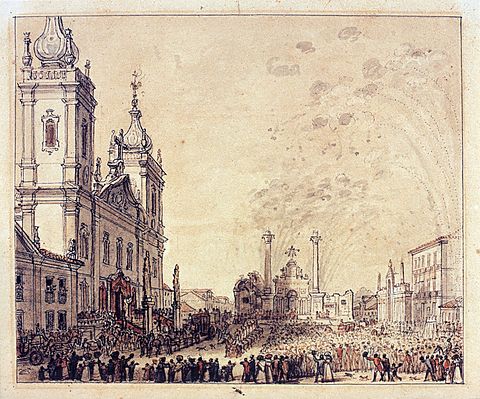
In 1825, a small group in Brazil's southernmost province, Cisplatina, declared independence. They were supported by a neighboring country, which wanted to take over Cisplatina. Brazil declared war in December, starting the Cisplatine War.
Pedro I traveled to different provinces to gain support for the war. While he was away, his wife, Maria Leopoldina, passed away. She died after a miscarriage. Pedro I felt great sadness and regret. The war continued, but without a clear end in sight. In August 1828, Pedro I gave up Cisplatina, and it became the independent country of Uruguay.
Second Marriage
After Maria Leopoldina's death, Pedro I realized how much he missed her. He decided to marry again and become a better person. He tried to convince his late wife's father that he was sincere.
However, because of his past behavior, many princesses in Europe refused to marry him. This hurt his pride. Finally, a marriage was arranged with Amélie of Leuchtenberg. They were married by proxy on 2 August 1829. When he met her, he was amazed by her beauty. Their wedding ceremony took place on 17 October.
Amélie was kind and loving to Pedro's children. She brought a sense of calm and happiness to his family. Pedro I kept his promise to change his behavior. He remained faithful to Amélie. He also made peace with his former minister, José Bonifácio.
Abdication and Return to Europe
Political Challenges
From 1823, there was a big debate in Brazil about how much power the emperor should have compared to the parliament. Pedro I believed the emperor should choose ministers and set government policies. Others, called the Liberal Party, thought that elected officials in parliament should have more power.
Pedro I always respected the Constitution. He did not cheat in elections or stop people from speaking freely. He did not close the parliament when they disagreed with him.
However, Liberal newspapers often criticized Pedro I because he was born in Portugal. They claimed he was secretly trying to reunite Brazil and Portugal. They also said his Portuguese friends in the court were part of these plots. These claims were not true.
Another criticism was about Pedro I's views on slavery. He wanted to end slavery gradually. But the parliament, which had the power to make laws, was made up of many slave owners. So, they stopped any attempts to abolish slavery. Pedro I tried to set an example by freeing his own slaves and giving them land. He also believed that all people were equal, regardless of their skin color.
Giving Up the Throne
Pedro I tried to make the Liberal Party happy. He supported a law in 1827 that made ministers responsible to the parliament. In March 1831, he even appointed a cabinet made of Liberal politicians. He also sent his Portuguese friends away to stop rumors about a "secret cabinet."
But these efforts did not stop the attacks from the Liberals. They kept criticizing his government and his Portuguese birth. Pedro I became very frustrated.
Meanwhile, Portuguese people living in exile tried to convince him to leave Brazil. They wanted him to focus on getting his daughter's throne back in Portugal. Pedro I loved adventure and fighting for a cause. He felt that helping his daughter was a noble quest.
He started talking about giving up his throne and returning to Portugal in 1829. An opportunity came in March 1831. There were fights in the streets of Rio de Janeiro between Brazilians and Portuguese people. On 5 April, Pedro I fired the Liberal cabinet because they couldn't restore order.
On 6 April, a large crowd gathered and demanded the old cabinet be brought back. Pedro I replied: "I will do everything for the people and nothing [compelled] by the people." That night, army troops, including his own guard, joined the protests. Pedro I realized he was alone. To everyone's surprise, he gave up his throne around 3:00 AM on 7 April. He handed the abdication paper to a messenger and said: "Here you have my act of abdication, I'm returning to Europe and leaving a country that I loved very much, and still love."
Back in Europe
Fighting for His Daughter

On the morning of 7 April, Pedro, his wife Amélie, his daughter Maria II, and his sister Ana de Jesus boarded a British warship. On 13 April, he sailed for Europe. He arrived in France on 10 June. He visited France and Great Britain, but neither government gave him real support to restore his daughter's throne.
Since he was no longer emperor or king, Pedro took the title of Duke of Braganza on 15 June. This title was usually for the heir to the Portuguese throne. On 1 December, his daughter with Amélie, Princess Maria Amélia of Brazil, was born in Paris.
Pedro did not forget his children in Brazil. He wrote them heartfelt letters, telling them how much he missed them and urging them to study hard. He once told his son, Pedro II: "I intend that my brother Miguel and I will be the last badly educated of the Braganza family."
In Paris, Pedro became friends with Gilbert du Motier, marquis de Lafayette, a hero of the American Revolutionary War. With limited money, Pedro put together a small army. It was made up of Portuguese liberals, foreign soldiers, and volunteers. On 25 January 1832, Pedro said goodbye to his family. He knelt before Maria II and said: "My lady, here is a Portuguese general who will uphold your rights and restore your crown."
Pedro and his army sailed to the Azores islands, which were still loyal to his daughter. After preparing for a few months, they sailed to mainland Portugal. They entered the city of Porto without a fight on 9 July. His brother Miguel's troops then surrounded the city, starting a siege that lasted over a year.
Final Victory and Death
In early 1833, while still under siege in Porto, Pedro received sad news from Brazil: his daughter Princess Paula of Brazil had died.
During the war, Pedro I was very active. He helped set up cannons, dug trenches, cared for the wounded, and fought bravely. His cause seemed almost lost until he took a big risk. He divided his forces and sent some to attack southern Portugal by sea. This expedition captured the Algarve region and then marched north to Lisbon, which surrendered on 24 July.
Pedro continued to fight to take back the rest of the country. His Spanish uncle, Don Carlos, also got involved in a wider conflict across Spain and Portugal. Pedro I teamed up with liberal Spanish armies and defeated both Miguel I and Carlos. A peace agreement was signed on 26 May 1834.
Pedro had always been healthy, except for occasional epilepsy attacks. But the war had weakened him. By 1834, he was dying of tuberculosis. He was confined to his bed in Queluz Royal Palace from 10 September.
Pedro wrote a letter to the Brazilians, asking them to gradually end slavery. He warned them: "Slavery is an evil... It is a cancer that devours its morality." Pedro died on 24 September 1834. As he wished, his heart was placed in a church in Porto, and his body was buried in the Royal Pantheon of the House of Braganza.
Legacy and Remembrance
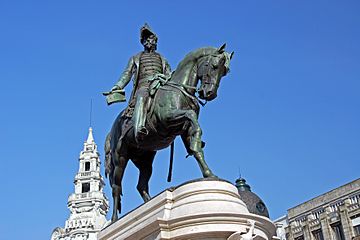
After Pedro I's death, people could look back at his life more fairly. Even his critics agreed he was a very important figure. One of them, Evaristo da Veiga, said that Pedro I was a "powerful instrument of liberation" for both Brazil and Portugal. He said that if Brazil is a free nation today, it owes a lot to Pedro I's decision to stay and declare independence. Portugal also owes its representative government to his efforts and sacrifices.
John Armitage, who lived in Brazil during Pedro I's reign, said that even the emperor's mistakes helped bring good changes. He saw Pedro I as a person who helped bring about important revolutions. He believed Pedro I made up for his past errors by bravely fighting for freedom in Portugal.
In 1972, for Brazil's 150th independence anniversary, Pedro I's remains were brought to Brazil. This was done with great ceremony, as he had asked in his will. His remains were reburied in the Monument to the Independence of Brazil in São Paulo, along with his two wives.
Historian Neill Macaulay noted that Pedro I was often criticized, which led him to give up two thrones. His willingness to let go of power and accept public criticism made him different from many rulers of his time. He was a leader who helped spread liberal ideas.
In 2022, for Brazil's 200th independence celebration, Pedro I's embalmed heart was brought to Brazil. It received military honors and was displayed to the public before returning to Portugal.
Titles and Honors
Official Titles
| Styles of Pedro I, Emperor of Brazil |
|
|---|---|
 |
|
| Reference style | His Imperial Majesty |
| Spoken style | Your Imperial Majesty |
| Royal styles of Pedro IV, King of Portugal |
|
|---|---|
 |
|
| Reference style | His Most Faithful Majesty |
| Spoken style | Your Most Faithful Majesty |
Pedro I had many titles throughout his life:
- 1798–1801: His Highness The Most Serene Infante Dom Pedro
- 1801–1816: His Royal Highness The Prince of Beira (heir to the throne)
- 1816–1817: His Royal Highness The Prince of Brazil
- 1817–1826: His Royal Highness The Prince Royal (in Portugal)
- 1822–1831: His Imperial Majesty The Emperor of Brazil
- 1826: His Most Faithful Majesty The King of Portugal
- 1831–1834: His Imperial Majesty The Duke of Braganza
As Emperor of Brazil, his full title was: "His Imperial Majesty Dom Pedro I, Constitutional Emperor and Perpetual Defender of Brazil."
As King of Portugal, his full title was: "His Most Faithful Majesty Dom Pedro IV, King of Portugal and the Algarves, of either side of the sea in Africa, Lord of Guinea and of Conquest, Navigation and Commerce of Ethiopia, Arabia, Persia and India, etc."
Nobility Titles
As the heir to the Portuguese crown, he held several noble titles:
- Duke of Braganza
- Duke of Barcelos
- Duke of Guimarães
- Marquis of Vila Viçosa
- Count of Ourém
- Count of Barcelos
- Count of Faria and Neiva
- Count of Arraiolos
- Count of Guimarães
Awards and Orders
As Emperor of Brazil, he was the Grand Master of these Brazilian Orders:
- Order of Christ
- Order of Aviz
- Order of Saint James of the Sword
- Order of the Southern Cross
- Order of Pedro I
- Order of the Rose
As King of Portugal, he was Grand Master of these Portuguese Orders:
- Order of Christ
- Order of Saint Benedict of Aviz
- Order of Saint James of the Sword
- Order of the Tower and Sword
- Order of the Immaculate Conception of Vila Viçosa
He also received honors from other countries:
- Knight of the Spanish Order of the Golden Fleece
- Grand Cross of the Spanish Order of Charles III
- Grand Cross of the Spanish Order of Isabella the Catholic
- Grand Cross of the French Order of Saint Louis
- Knight of the French Order of the Holy Spirit
- Knight of the French Order of Saint Michael
- Grand Cross of the Austro-Hungarian Order of Saint Stephen
Family Tree
Ancestors
| Ancestors of Pedro I of Brazil | |||||||||||||||||||||||||||||||||||||||||||||||||||||||||||||||||||||||||||||||||||||||||||||||||||||||||||||||||||||||||||||||||||||||||||||||||||||||||||||||||||||||||||||||||||||||||||||||||||||||||||||||||||||||||||||||||||||||||||||||||||||||||||||||||||||||||||||||||||||||||
|---|---|---|---|---|---|---|---|---|---|---|---|---|---|---|---|---|---|---|---|---|---|---|---|---|---|---|---|---|---|---|---|---|---|---|---|---|---|---|---|---|---|---|---|---|---|---|---|---|---|---|---|---|---|---|---|---|---|---|---|---|---|---|---|---|---|---|---|---|---|---|---|---|---|---|---|---|---|---|---|---|---|---|---|---|---|---|---|---|---|---|---|---|---|---|---|---|---|---|---|---|---|---|---|---|---|---|---|---|---|---|---|---|---|---|---|---|---|---|---|---|---|---|---|---|---|---|---|---|---|---|---|---|---|---|---|---|---|---|---|---|---|---|---|---|---|---|---|---|---|---|---|---|---|---|---|---|---|---|---|---|---|---|---|---|---|---|---|---|---|---|---|---|---|---|---|---|---|---|---|---|---|---|---|---|---|---|---|---|---|---|---|---|---|---|---|---|---|---|---|---|---|---|---|---|---|---|---|---|---|---|---|---|---|---|---|---|---|---|---|---|---|---|---|---|---|---|---|---|---|---|---|---|---|---|---|---|---|---|---|---|---|---|---|---|---|---|---|---|---|---|---|---|---|---|---|---|---|---|---|---|---|---|---|---|---|---|---|---|---|---|---|---|---|---|---|---|---|---|---|---|---|
|
|||||||||||||||||||||||||||||||||||||||||||||||||||||||||||||||||||||||||||||||||||||||||||||||||||||||||||||||||||||||||||||||||||||||||||||||||||||||||||||||||||||||||||||||||||||||||||||||||||||||||||||||||||||||||||||||||||||||||||||||||||||||||||||||||||||||||||||||||||||||||
Children
| Name | Portrait | Lifespan | Notes |
|---|---|---|---|
| With Maria Leopoldina of Austria (married 1817) | |||
| Maria II of Portugal | 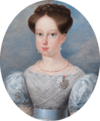 |
4 April 1819 – 15 November 1853 |
Queen of Portugal from 1826 to 1828, and again from 1834 to 1853. She had eleven children. |
| Miguel, Prince of Beira | 26 April 1820 | Died as a baby. | |
| João Carlos, Prince of Beira | 6 March 1821 – 4 February 1822 |
Died as a baby. | |
| Princess Januária of Brazil |  |
11 March 1822 – 13 March 1901 |
Married Prince Louis, Count of Aquila. She had four children. |
| Princess Paula of Brazil | 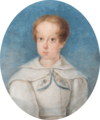 |
17 February 1823 – 16 January 1833 |
Died at age 9, likely from meningitis. |
| Princess Francisca of Brazil |  |
2 August 1824 – 27 March 1898 |
Married François, Prince of Joinville. She had three children. |
| Pedro II of Brazil | 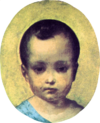 |
2 December 1825 – 5 December 1891 |
Emperor of Brazil from 1831 to 1889. He had four children. |
| With Amélie of Leuchtenberg (married 1829) | |||
| Princess Maria Amélia of Brazil | 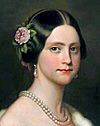 |
1 December 1831 – 4 February 1853 |
Lived in Europe and never visited Brazil. She was engaged to Maximilian, who later became Emperor of Mexico, but she died before they could marry. |
See also
 In Spanish: Pedro I de Brasil y IV de Portugal para niños
In Spanish: Pedro I de Brasil y IV de Portugal para niños
- Hino da Independência and Hino da Carta, both composed by Pedro I.
- Dom Pedro aquamarine, a very large gem named after Pedro I and his son.
- Equestrian statue of Pedro I, a statue in Rio de Janeiro built in his honor.
Images for kids



